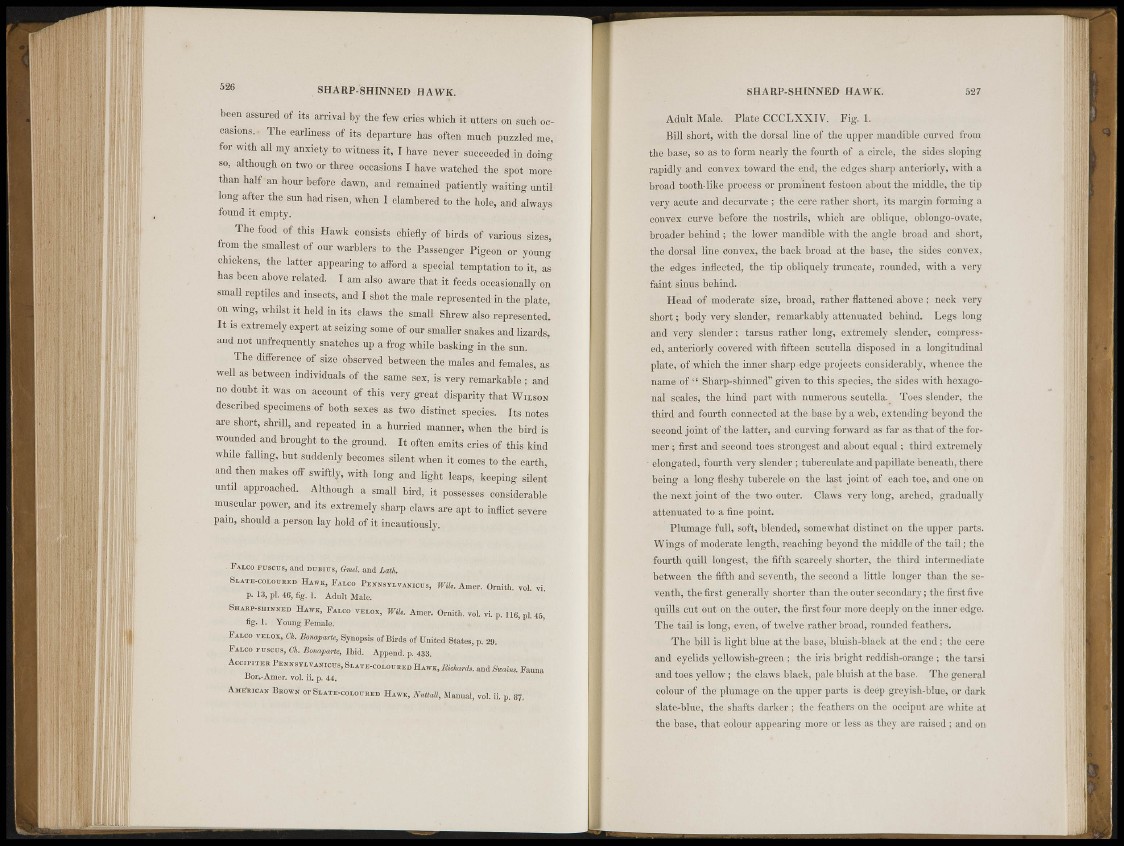
526 SHARP-SHINNED HAWK.
been assured of its ¡ a r r i v e l>y the few,cries which » utters on such occasions.
» The earliuess of its depart«« has often much puzzled me,
Ite with all my anxiety to witness it, I have nevr
a Succeeded.in doing
so, although on two or three occasions I have watched the spot more
than half-an hour Mor e daw.,, ami remained patiently waiting until
long .after the sun had risen, when I clambered to the hole, and always
found it empty.
The food of this-Hawk consists .chfe% of birds of various, SU&K"
from the smallest-of our warblers to the Passenger Pigeoa or young
chickens; the latter appearing to afiord a special temptation to it, n*
has been above related. I am also aware that it feeds occasionally on
small reptiles and insects, and I shot the male r e p r i n t e d in the plate,
w h i k l held »' ito oftfi small Shrew also represented,
I t f l . extremply expert at^izing some of our smaller snakes and lizards^
!U"1 * «frequently snatches up a frog while basking in the sun,
The difference (^gjlg^bserved between the males and females, as
well as between-individuaJs of the same sex, is,very remarkable; and
no doub^it was on account of this very great disparity that WiLaox
described specimens,** both sgx^as two distinct ^ m , Its notes
«<• short, shrill, and repeated ijj,» hurried maimer, when the bird is
wounded, and brought to the ground, »often emits cries of this kind
while,faffing, Imt suddenly becomes silent when it comes to the earth
,and Jhga makes off swiftly, with long and light leaps, keeping. . ^
untd approached, „Althoiigh, a small bird, it possesses considerable
muscular power, and its extremely sharp claws are apt to mfhct severe
pain, should a person lay hold uf it incautiously.
. FAICO *jp|p|, and i)umr.<, Cm/. iu:D /.it/,.
SIIATE-COIIOURED HA„Z, FAJ.00 PmYivAtficm, WW,. Amet. Onuth. vol J " I
p. 13,^1. 46, fig. 1. kdnlt Male. '
8 . « H E D ™ - H A B , F^ciVvix«, vnu. W Ornitl, v&i ip. ne,pl.45
%• I. Young Female.
Vu.cn VKLOX, a . Hvmpam, SynopA „MI N I S ,,f i:„it(«l.»tat(«, p. 2».
Ibid. Append, p. 433.
Accrr™ P W ™ « ™ ^ S L « ® OT7M
D HAWK, BU^d*.mi Svmm. Fanma
Bor.-Amer. voL ii. p. 44.
AMERICAN BROWN or SLATE-COLOURED HAWK, JSTuttaU, Manual, vol. ii. p. 87,
SHARP-SHINNED HAWK. 527
Adult Male. Plate CCCLXXIV. Fig. 1.
Bill short, with the dorsal line of the upper mandible curved from
the base, so as to form nearly the fourth of a circle, the sides sloping
rapidly and convex toward the end, the edges sharp anteriorly, with a
broad tooth-like process or prominent festoon about the middle, the tip
very acute and decurvate ; the cere rather short, its margin forming a
convex curve before the nostrils, which are oblique, oblongo-ovate,
broader behind; the lower mandible with the angle broad and short,
the dorsal line convex, the back broad at the base, the sides convex,
the edges inflected, the tip obliquely truncate, rounded, with a very
faint' sinus behind.
Head of moderate size, broad, rather flattened above ; neck very
short; body very slender, remarkably attenuated behind. Legs long
and very slender; tarsus rather long, extremely slender, compressed,
anteriorly covered with fifteen scutella disposed in a longitudinal
plate, of which the inner sharp edge projects considerably, whence the
name of4 4 Sharp-shinned" given to this species^ the sides with hexagonal
scales, the hind part with numerous scutella. Toes slender, the
third and fourth connected at the base by a web, extending beyond the
second joint of the latter, and curving forward as far as that of the former
; first and second toes strongest and about equal; third extremely
• elongated, fourth very slender ; tuberculate and papillate beneath, there
being a long fleshy tubercle on the last joint of each toe, and one on
the next joint of the two outer. Claws very long, arched, gradually
attenuated to a fine point.
Plumage full, soft, blended, somewhat distinct on the upper parts.
Wings of moderate length, reaching beyond the middle of the tail; the
fourth quill longest, the fifth scarcely shorter, the third intermediate
between the fifth and seventh, the second a little longer than the seventh,
the first generally shorter than the outer secondary; the first five
quills cut out on the outer, the first four more deeply on the inner edge.
The tail is long, even, of twelve rather broad, rounded feathers.
The bill is light blue at the base, "bluish-black at the end; the cere
and eyelids yellowish-green ; the iris bright reddish-orange ; the tarsi
and toes yellow; the claws black, pale bluish at the base. The general
colour of the plumage on the upper parts is deép greyish-blue, or dark
slate-blue, the shafts darker ; the feathers on the occiput are white at
the base, that colour appearing more or less as they are raised ; and on